Astronomy Notes
Part 1: Terms and Basics
Dr. John P. Pratt
Updated 7 Sep 2004
The Scientific Method
Science is based on the "Scientific Method." It has three steps which are usually repeated many times in succession. These steps are:
- Make Observations. The observations are often called "facts", but that doesn't mean they are always correct.
- Propose a Theory. A theory or hypothesis is a proposed explanation of the observations.
- Use the Theory to Predict Future Observations.
- To be scientific, the theory must be able to predict the outcome of a future observation.
- Falsification refers to the possibility that the theory will be disproven if the prediction fails.
- Theories which makes no verifiable predictions are not scientific, even though they might be correct explanations.
Note that while a scientific theory can be disproven by any one experiment, it can never be proven true, because a new falsification experiment might prove it false. Thus, all scientific results are provisional and not believed to be absolutely true.
Truth is how things "really are," and so truth is entirely outside of the realm of science. Truth is usually hidden, such as a person's motives or ultimate causes. Truth is the subject of religion, philosophical speculation and courtrooms, but not of science.
Daily Application. When anyone tells you anything, try to separate the facts (observations) from the theories (explanations). Example: "The stock market fell 300 points today because of Mid-east tension." The fact is the stock market fell, the theory is it was caused by Mid-east concerns, and the truth of what "really" governs the stock market is probably not known to anyone.
Introduction to Astronomy
The universe usually means "everything that exists." In astronomy we study the observable part of the universe.
Powers of 10 are used everywhere in astronomy, so become very familiar with them.
- 10n means 1 followed by "n" zeros. For example, 106 = 1,000,000 = one million.
- 10-n means 1/10n. For example 10-9 =
1/109 = 1/1,000,000,000 = one billionth.
The SI metric system, which our text uses, has three basic units.
- Meters for length (m). 1 m = 39.37" The idea was that it is 107 m from equator to pole.
- Kilograms for mass (kg). 1 kg = 2.2 lbs. 1 kg of water has volume of a cube 0.1 m on a side.
- Seconds are used for time.
The metric system has units in powers of ten for ease in computations, with prefixes
- nano = 10-9 = 1/1,000,000,000, as in nanometers (nm). The speed of light is 1 foot per nanosecond.
- micro = 10-6 = 1/1,000,000, abbreviated µ. A micrometer is often called simply a micron.
- milli = 10-3 = 1/1,000. Used everywhere: millimeters (mm), milligrams (mg), milliseconds.
- centi = 10-2 = 1/100. Mostly important for centimeters (cm). 1 inch is exactly 2.54 cm.
- kilo = 103 = 1,000. One kilometer (km) = 5/8 mile. Time in hours, years, not kiloseconds.
- mega = 106 = 1,000,000. Mostly used for MB, megabytes. Megameters and Megagrams never caught on.
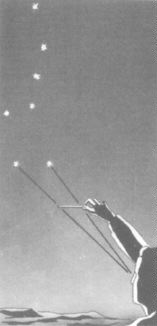 |
The Pointers are separated by 5°.
Angular Measure is used to measure arc lengths in the sky.
- A circle has 360° (degress). The distance between the pointers of the Big Dipper is about 5°. The angle is formed by drawing a line from the star to your eye to the other star, but the best way to think of it is like a flat ruler placed on the sky.
- One degree = 60' (minutes). The sun's or moon's diameter is about 30', or 1/2°.
- One minute = 60" (seconds). One second is the smallest separation visible in most telescopes.
Angular Measure is also used to measure arc lengths on the spherical earth.
- 1° is the north-south length of the corner missing from the otherwise rectangular shape of Utah.
- 1' of latitude is one nautical mile (a little more than a usual mile).
- 1" of latitude is almost exactly 100 feet.
- Note that angles of longitude are less than latitude because longitudinal lines get closer together
as one approaches the poles. For example, Utah is 5° high and 5° wide, but it doesn't look square.
Astronomical Terms Describing Sky's Motion
Even though we now know that the earth is spherical, rotates daily on its axis, and revolves around the sun, the best way to actually understand the motion of the starry sky is think of yourself as at the center of a circular flat earth, with the sun, moon, planets and stars all at the same distance, as if attached to the inside of a planetarium dome. With that in mind, you need to know the following terms:
The Celestial Sphere: A simplified model of the sky, where all the stars are considered to be the same distance away from us, on the inside surface of a sphere, called the "celestial sphere."
Zenith: The point on the celestial sphere exactly overhead.
Meridian: The North-South semi-circle on the celestial sphere from the north point on the horizon, passing through the zenith to the south point on the horizon.
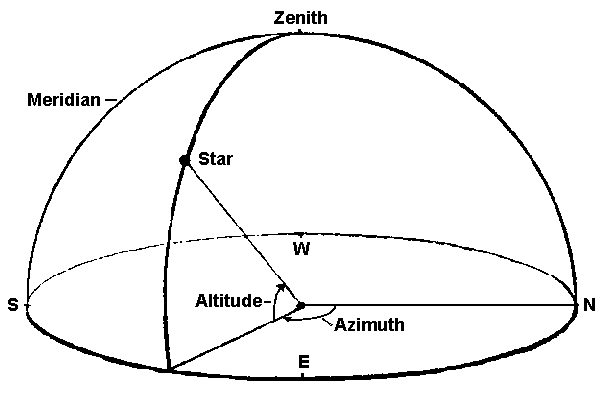 |
Altitude & Azimuth
Because we are ignoring the distances to the stars, only two coordinates (numbers) are used to describe exactly where a star in the sky is (see illustration):
- Azimuth: The angle along the horizon measured from North through East to the point
directly below the desired point in the sky.
- Altitude: The angle from the horizon measured vertically up to the point.
The north celestial pole is the point in the sky above the earth's north pole.
- It is located due north on the meridian, at an altitude equal to your latitude on earth.
- Everything in the sky appears to be rotating around the celestial pole because the earth
is rotating. The moon, planets, and stars rise in the east and set in the west like the sun.
- Circumpolar stars are those in the north which never set, but only make circles around the pole.
The North Star (Polaris), is a star that is within 1° of the north celestial pole.
- It makes only tiny circles in the sky and so is always found within 1° of due north.
- The "pointer" stars of the Big Dipper point to the North Star, nearly 30° away.
The celestial equator is the circle in the sky which is 90° away from the north celestial
pole.
- It is also a projection of the earth's equator onto the sky, and it always goes through the points on the horizon due east and west.
- All of the stars move parallel to the celestial equator as the appear to rotate around the pole.
The ecliptic is the apparent path of the sun through the sky as the earth orbits the sun.
- The ecliptic is a circle on the celestial sphere, tilted 23 1/2° to the celestial equator.
- The 12 constellations found along the ecliptic are called the zodiac.
- Each year the sun spends about one month in each constellation of the zodiac.
- The moon and most of the planets are always found close to the ecliptic.
Constellations are the ancient figures which form a pictorial star map.
- 48 constellations are extremely old, dating to about 2900 B.C. 40 more have been added recently.
- If you learn the constellations, you can find things in the sky without any other map.
- For example, the Great Nebula in Orion is the middle star in Orion's sword.
Observing the Sun
The Sun Moves Eastward through the zodiac 1° daily
- As the earth revolves around the sun, the sun appears to move through the zodiac.
- In 365 days, the sun moves through 360°, averaging about 1° per day.
- The sun's motion means the stars rise 4 minutes earlier each night, or 2 hours earlier per month.
- The sun spends about one month in each sign of the zodiac.
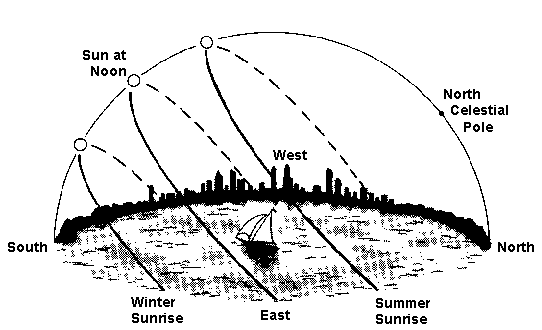 |
The Seasonal Path of the Sun.
Seasons are caused because the earth's rotation axis is tilted 23 1/2° to the ecliptic.
- For most latitudes, the sun rises due east in March, in the north-east in June, then back in the east in September, and finally in the south east in December.
- Ancient people built monuments and markers to indicate these directions to track seasons.
- Egyptians built temples with openings where the sun would illuminate a target once a year.
- The ancient Britons built Stonehenge in England with huge stones as markers.
- Native Americans used stone marker "medicine wheels" for this purpose.
- The equinoxes (about Mar. 21 and Sep. 23) are when the days and nights are equal and the sun rises due east. They are also the two points on the celestial sphere where the ecliptic and celestial equator intersect. On those to dates, the sun is located at those points in the sky.
- The summer solstice (about Jun. 21) is when the sun rises farthest north when the days are the longest (in the northern hemisphere).
- The winter solstice (about Dec. 21) is when the sun rises farthest south and the days are shortest.
- It is hotter in summer because the sun is more directly overhead and the days are longer.
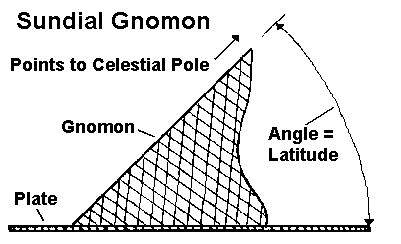 |
Sundials
- Sundials use a shadow formed by a style or gnomon (pronounced "know-mon") to tell time.
- The sundial face can be on a horizontal, vertical, or even round surface.
- The angle of a gnomon should be the same as the lattitude so that it points to the celestial pole.
- The dial can be rotated for zone time, and for daylight savings time.
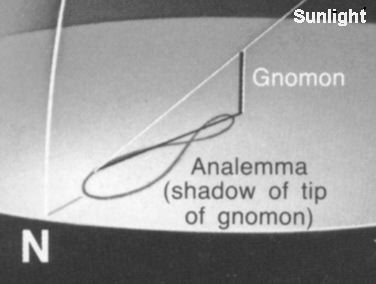 |
The Analemma
The Analemma
- The Analemma is the large figure 8 shown in the Pacific Ocean on many globes.
- Is it traced annually on the ground by the tip of a sundial gnomon exactly at noon each day.
- It is a graph of how fast or slow a sundial is on any given day.
- The loops are caused because the sun's motion is nearly uniform along the ecliptic, but
time is measured along the celestial equator, so the sun appears to go faster and slower than average.
- The loops are of unequal size because of the eccentricity of the earth's orbit.
- The result is that sundials go fast in the fall and slow in the spring.
Our solar calendar is designed to stay aligned with the seasons.
- The length of the year is 365.24 days, so leap days are added to a 365 day year.
- The old Julian Calendar inserted one day every four years to average exactly 365.25 days.
- The Gregorian Calendar which we now use skips 3 out of 4 leap years in centuries to average 365.24 days.
- The year 2000 will be a leap year, being the century that we do not skip the leap year.
- Before 1751 the English version of the Julian Calendar, called "Old Style," began the year on March 25.
Observing the Moon
The moon's phases are caused because as the moon orbits the earth, we can only see part of the half of the moon that the sun lights up.
- A new moon is approximately between the earth and the sun, and hence invisible.
- A crescent moon is one to three days before or after new.
- A first quarter moon is about 90° from the sun, and is high in the sky at sunset.
- A full moon is opposite the sun in the sky, rising at sunset and setting at sunrise.
- A gibbous moon is one to three days before or after full, when the moon looks nearly circular.
- A last quarter moon is also about 90° from the sun, but it rises at midnight and is high in the sky at dawn.
 |
The crescent moon correctly indicates about 4 a.m.
The bright part of the moon is always lit by the sun, so draw it that way in pictures. For example, a crescent moon in a dark sky must be tipped to where the sun would be below the horizon.
The moon rises about 50 minutes later every night, and it moves 13° westward through the stars nightly.
A lunisolar calendar tracks both the sun and the moon.
- The moon's new, first quarter, full, and last quarter phases take 29.53 days for a cycle.
- Lunisolar calendars begin their months at the new moon.
- Lunar months are either 29 or 30 days, so that they always begin at the new moon.
- Lunisolar calendars insert an entire 13th leap month to keep aligned with the seasons.
Eclipses occur when the sun and moon align and one is in the other one's shadow.
- Solar eclipses occur when the earth is in the moon's shadow, so the new moon blocks out the sun.
- A solar eclipse is total if the moon completely hides the sun, and partial if it doesn't.
- Solar eclipses are only visible on tiny strips of the earth's surface, so it is rare to repeat at the same place.
- A total solar eclipse lasts about three minutes.
- There is a solar eclipse somewhere on earth every couple of years; people take ocean cruises to see them.
- During a total solar eclipse the temperature drops 25° F and the stars are visible.
- Lunar eclipses occur when the full moon enters the earth's shadow, and turns red or grey.
- A lunar eclipse is total if the moon entirely enters the earth's shadow, and partial otherwise.
- Lunar eclipses are visible to the entire dark half of the earth, so they commonly repeat at the same place.
- A total lunar eclipse lasts about an hour.
- Lunar eclipses occur every 2-3 years.
- Predicting Eclipses is somewhat difficult, for many conditions must be just right.
- The moon must be new (invisible because it is approximately in front of the sun), which happens monthly.
- The moon must also be on the ecliptic (hence the word "ecliptic" comes from "eclipse"). The moon's orbit
is tilted about 5° to the ecliptic; the two places it crosses are called nodes. Thus, the
moon must be at a node of its orbit.
- That combination can occur at most twice in a year (actually in an eclipse year of about 347 days).
- The ancients knew an eclipse can reoccur after a period of about 18 years called a saros.
- Often a solar eclipse at the new moon will be followed by a lunar eclipse two weeks later at the full moon.







